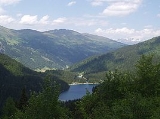
Obernberg am Brenner
Encyclopedia
Obernberg am Brenner is a municipality in the southern Innsbruck-Land District, Tirol
with a population of 360 (2010), an area of 38,66 square kilometres at an elevation of 1380 metres.
in a Valley, with the same name, which depart from the west side of Wipptal at Gries am Brenner. The valley has end with the massif of Schwarze Wand and the group of the Tribolaum.
The popular Obernberger See
is visited by tourists; the Obernberger Seebach
flows through the village and provides Obernberg with drinking water.
Tyrol (state)
Tyrol is a state or Bundesland, located in the west of Austria. It comprises the Austrian part of the historical region of Tyrol.The state is split into two parts–called North Tyrol and East Tyrol–by a -wide strip of land where the state of Salzburg borders directly on the Italian province of...
with a population of 360 (2010), an area of 38,66 square kilometres at an elevation of 1380 metres.
Geography
Obernberg am Brenner is located nearly 30 km south from InnsbruckInnsbruck
- Main sights :- Buildings :*Golden Roof*Kaiserliche Hofburg *Hofkirche with the cenotaph of Maximilian I, Holy Roman Emperor*Altes Landhaus...
in a Valley, with the same name, which depart from the west side of Wipptal at Gries am Brenner. The valley has end with the massif of Schwarze Wand and the group of the Tribolaum.
The popular Obernberger See
Obernberger See
Lake Obernberg lies at an elevation of 1,590 metres in the valley with the same name near the Brenner Alps. With such a big area size and volume it is the biggest Lake on the southern side of Tyrol. The fresh water is provided subterranean by the Obernberger Seebach...
is visited by tourists; the Obernberger Seebach
Obernberger Seebach
The Obernberger Seebach, formerly called Obernberger Ache, is a river in Austria originating south-west of Brenner and taking a north-east route to the Sill River. In the middle of the valley the brook passes through the village of Obernberg am Brenner. From the spring until to the mouth it...
flows through the village and provides Obernberg with drinking water.

